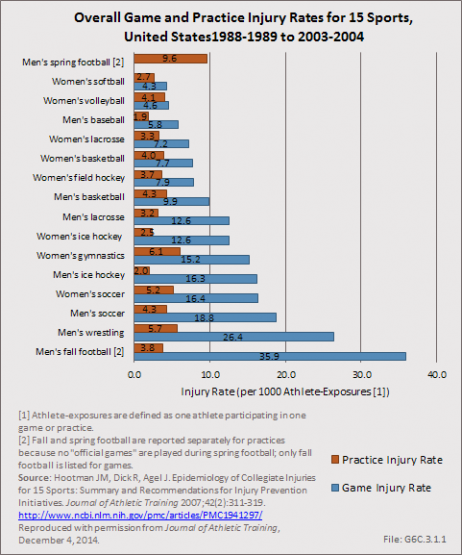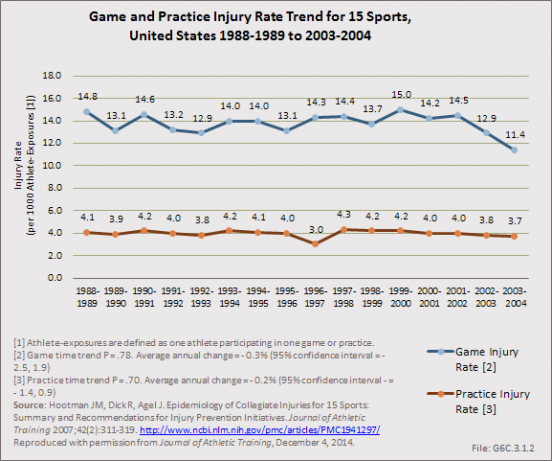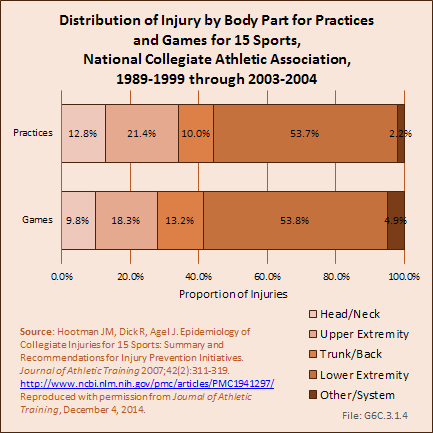

The National Collegiate Athletic Association [1] (NCAA)1 is comprised of nearly 1,100 member schools that compete in three division levels. More than 375,000 student athletes participate in NCAA sports that offer national championships annually, and this number continues to grow.2 During the 2013–2014 academic year, the number of teams competing in NCAA championship sponsored sports reached an all-time high of 19,086.
While there are numerous benefits associated with participating in collegiate athletics, there is also an increased risk of injury associated with participating in many types of sports. These injuries primarily affect the musculoskeletal system in general, and the lower and upper extremities specifically. Although awareness of risk of injury associated with participating in collegiate athletics is growing, there is little known about the long-term impact of injuries sustained while participating in collegiate athletics. Recent injury data from the NCAA Injury Surveillance System [2], as well as reports for specific joint injuries sustained by NCAA athletes and emerging data on the potential long-term impact of these injuries on health-related quality of life is presented.
For more than 30 years the NCAA, and since 2009 the Datalys Center [3], have been engaged in active injury surveillance within the unique population of college athletes. The collaborative effort between the NCAA and the National Athletic Trainers’ Association [4] (NATA) has yielded rich injury surveillance data used to develop important rule changes to protect player safety.3 In a 2007 special issue of The Journal of Athletic Training, data from the NCAA injury surveillance system from the 1988–1989 academic year through the 2003–2004 academic year were reviewed for 15 collegiate sports.4 With permission from the publisher, data from this study is included in this site. To read the full article, click here [5].
The 15 sports examined included five fall sports (men’s football, women’s field hockey, men’s soccer, women’s soccer, and women’s volleyball), six winter sports (men’s basketball, women’s basketball, women’s gymnastics, men’s gymnastics, men’s ice hockey, and men’s wrestling), and five spring sports (men’s baseball, men’s football, women’s softball, men’s lacrosse, and women’s lacrosse). Data for men’s spring football were only included in the analysis of practice injuries. These data provide insight into the burden of musculoskeletal injury experienced by collegiate athletes.
Hootman et al4 provided an overall summary of the NCAA data from the years 1988–1989 through 2003–2004, and made recommendations for injury prevention initiatives. Some of these data are highlighted in this section. CDC, which estimates 2.6 million children ages 0 through 19 years are treated in EDs each year for sports- and recreation-related injuries5, provides tips on how to prevent sports-related injuries in their Protect the Ones You Love Initiative [6].
Overall, incidence rates for the 15 sports examined range from a high of 35.9 per 1,000 game athlete exposures for men’s football to a low of 1.9 for men’s practice basketball. Among men, the highest injury rates were observed in football, wrestling, soccer, and ice hockey. Among women, the highest injury rates were experienced in soccer, gymnastics, ice hockey, and field hockey. (Reference Table 6C.9 PDF [8] CSV [9])
When data for all 15 sports are combined, injury rates are significantly higher in games (13.8 injuries per 1,000 athlete exposures) when compared to practice (4.0 injuries per 1,000 athlete exposures). Pre-season practice injury rates were significantly higher when compared to in-season or post-season training sessions. (Reference Table 6C.8 PDF [10] CSV [11])
Combined injury rates for all 15 NCAA sports studied remained relatively stable over time. No significant changes were observed in injury rates during games or practices over the 16-year study period. (Reference Table 6C.10 PDF [12] CSV [13])
The majority of injuries resulted from contact with another player, regardless of whether or not injuries were sustained in practices or games. (Reference Table 6C.11 PDF [14] CSV [15])
The majority of injuries documented during the study period affected the musculoskeletal system, with 72% of all injuries in games and 75% of all injuries in practices affecting the extremities. Regardless of whether injuries occurred in practices or games, more than one-half of all injuries reported across the 15 sports examined during the study period were to the lower extremity. (Reference Table 6C.12 PDF [16] CSV [17])
The NCAA injury surveillance system has also been used to examine the incidence and injury patterns of specific injuries among collegiate athletes.1,2 These studies have primarily focused on those injuries that likely have the greatest burden in terms of time loss from sport, the need for surgical intervention, and the potential for long-term impact on health. Specifically, joint injuries have been a primary concern, as it is well documented that these injuries can lead to chronic instability and increase the risk of osteoarthritis and degenerative joint disease.
Acute traumatic anterior cruciate ligament (ACL) injuries in the knee often lead to chronic pain and instability, and generally require surgical repair to restore function. There is also substantial evidence to suggest that acute traumatic knee joint injuries such as ACL tears significantly increase the risk for post-traumatic osteoarthritis. Several studies have focused on the rate of ACL injuries among collegiate athletes.1,3,4,5,6 Hootman et al6 estimated that approximately 2,000 athletes participating in 15 different men’s and women’s NCAA sports sustain an ACL tear annually. The average annual rate of ACL injury during the 16-year study period examined was 0.15 per 1,000 athlete-exposures. Arendt and Dick4 first reported that there were disparities in ACL injury incidence rates between males and females participating in the NCAA gender matched sports of soccer and basketball. This observation was confirmed in a follow-up study that examined data from 1990 through 2002.3 in male soccer players, Hootman et al6 reported that ACL injury rates among males and females combined, participating in 15 different NCAA sports, significantly increased during the 16-year study period. On average, they reported a 1.3% annual increase in the rate of ACL injury over time (P=0.02). (Reference Table 6C.14 PDF [18] CSV [19])
Dragoo et al7 compared ACL injury rates between NCAA football players participating on artificial turf and those participating on natural grass. They reported that the rate of ACL injury on artificial surfaces was significantly higher (1.39 times higher) than the injury rate on grass surfaces. They also noted that non-contact injuries occurred more frequently on artificial turf surfaces (44.29%) than on natural grass (36.12%).
Ankle sprains are also common among NCAA athletes and they frequently lead to chronic pain, instability, and functional limitations. Hootman et al6 estimated that approximately 11,000 athletes participating in 15 different men’s and women’s NCAA sports sustain an ankle sprain annually. The average annual rate of ankle sprain injury during the 16-year study period examined was 0.86 per 1,000 athlete exposures. They also examined the annual injury rates for ankle sprains among males and females participating in these sports combined between 1988 and 2004 and reported that injury rates remained constant during the 16-year study period. On average, there was a nonsignificant 0.1% (P=0.68) annual decrease in the rate of ankle sprains during the study period. (Reference Table 6C.13 PDF [20] CSV [21])
Shoulder instability also impacts a significant number of NCAA athletes and can lead to chronic pain, recurrent instability, and functional limitations. Recurrent shoulder instability has also been associated with the increased risk of osteoarthritis in the shoulder. Surgical reconstruction is common following shoulder instability in young athletes. Owens et al2 examined the injury rates and patterns for shoulder instability among NCAA athletes over the 16-year period from 1988 through 2004 in the same 15 sports described previously. The overall injury rate for shoulder instability during the study period was 0.12 per 1,000 athlete exposures. On average, this is comparable to just under 2,000 shoulder instability events experienced annually in NCAA athletes. Injury rates for shoulder instability were significantly higher in games when compared to practice. Overall, NCAA athletes were 3.5 (95%CI: 3.29–3.73) times more likely to experience shoulder instability events in games when compared to practices. Just over half (53%) of the shoulder instability events documented during the study period were first-time instability events, with the remaining injuries being recurrent instability events (47%). The majority of shoulder instability events were due to contact with another athlete (68%) and other contact (20%). Nearly half (45%) of all shoulder instability events experienced by NCAA athletes during the study period resulted at least 10 days of lost playing time, with the remainder returning to play within 10 days of injury.
Links:
[1] http://www.ncaa.org/
[2] http://www.datalyscenter.org/ncaa-injury-surveillance-program/
[3] http://datalyscenter.org/
[4] http://www.nata.org/
[5] http://www.ncbi.nlm.nih.gov/pmc/articles/PMC1941297/.
[6] http://www.cdc.gov/safechild/Sports_Injuries/index.html
[7] http://www.cdc.gov/safechild/index.html
[8] https://bmus.latticegroup.com/docs/T6C.9.pdf
[9] https://bmus.latticegroup.com/docs/T6C.9.csv
[10] https://bmus.latticegroup.com/docs/T6C.8.pdf
[11] https://bmus.latticegroup.com/docs/T6C.8.csv
[12] https://bmus.latticegroup.com/docs/T6C.10.pdf
[13] https://bmus.latticegroup.com/docs/T6C.10.csv
[14] https://bmus.latticegroup.com/docs/T6C.11.pdf
[15] https://bmus.latticegroup.com/docs/T6C.11.csv
[16] https://bmus.latticegroup.com/docs/T6C.12.pdf
[17] https://bmus.latticegroup.com/docs/T6C.12.csv
[18] https://bmus.latticegroup.com/docs/T6C.14.pdf
[19] https://bmus.latticegroup.com/docs/T6C.14.csv
[20] https://bmus.latticegroup.com/docs/T6C.13.pdf
[21] https://bmus.latticegroup.com/docs/T6C.13.csv